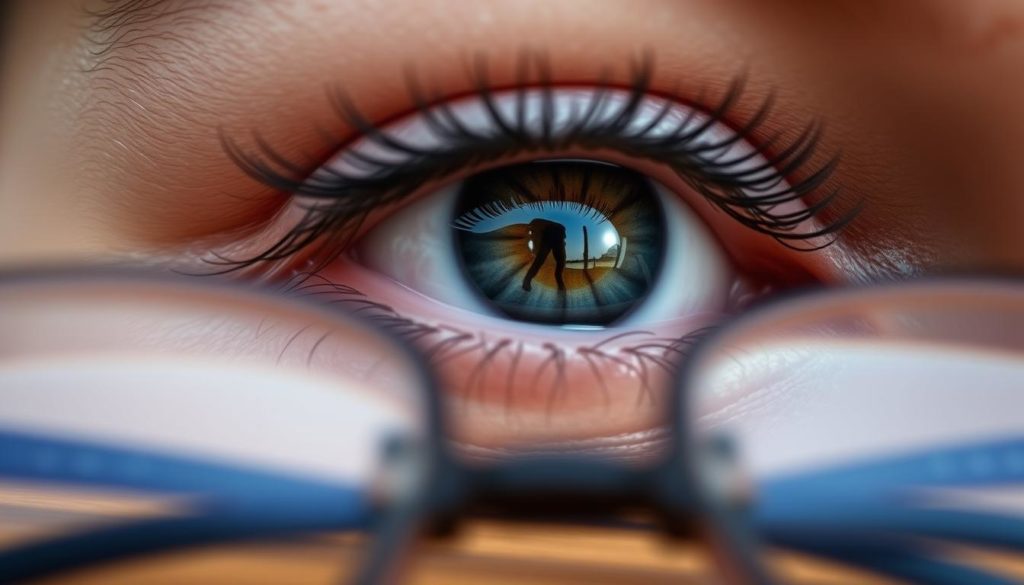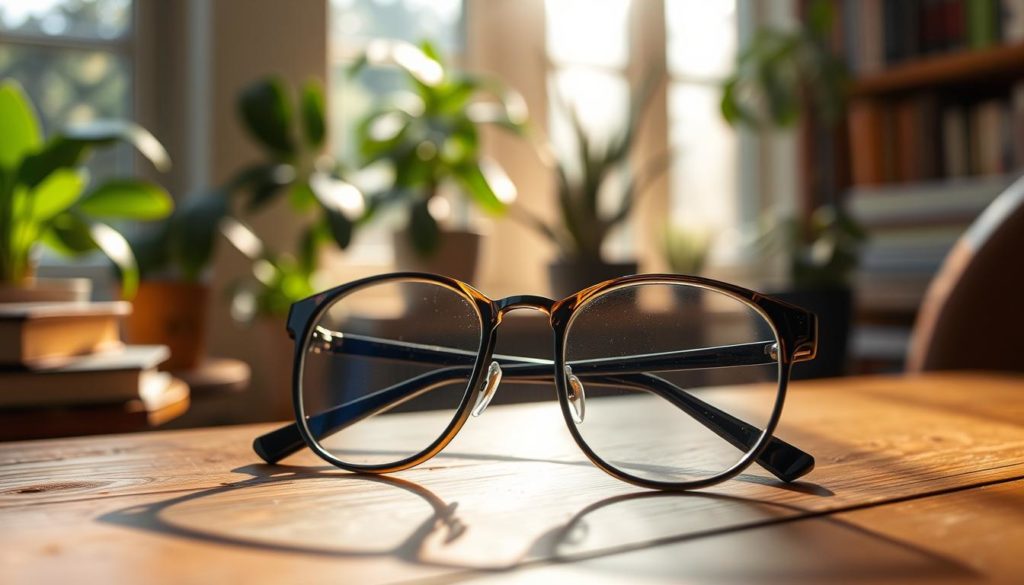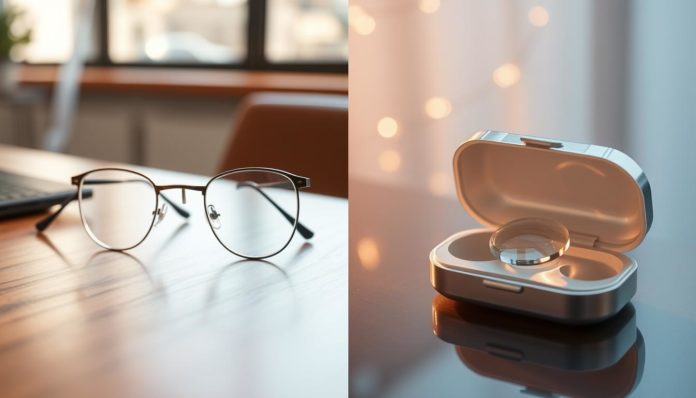Did you know 45 million Americans wear contact lenses as their main vision correction? This shows a big trend towards contacts over glasses. Yet, nearly 164 million U.S. adults still prefer glasses. So, how do you pick between contacts and glasses?
Your choice depends on comfort, lifestyle, and cost. It’s key to look at both sides to make a smart choice. This article will help you understand contacts and glasses. It aims to guide you in picking the best for your life.
Understanding Contact Lenses
Learning about contact lenses starts with knowing the different types. Each type has its own benefits and features. They cater to various vision needs and lifestyles.

Types of Contact Lenses
There are many types of contact lenses to pick from. You have soft lenses and rigid gas permeable (RGP) lenses. Each type has its own advantages:
- Soft Lenses: These are the most common. They are known for being comfortable and easy to adjust to. They include daily disposables and extended wear contacts.
- RGP Lenses: RGP, or rigid gas permeable lenses, are more durable. They provide clearer vision for certain eye conditions.
- Extended Wear Contacts: These lenses can be worn continuously for up to 30 days.
- Daily Disposables: These lenses are for single-day use. They offer a fresh pair every day, reducing infection risk.
Benefits of Contact Lenses
Contact lenses have many benefits over glasses. Some key advantages include:
- They are nearly invisible, making them more aesthetically pleasing.
- They offer a wider field of vision compared to glasses.
- They are more comfortable, especially with soft lenses or permeable lenses.
- They are flexible for an active lifestyle.
Common Myths About Contacts
Despite their popularity, many myths surround contact lenses. Some of the most common include:
“Contact lenses can get lost behind your eye.”
It’s physically impossible for contact lenses to get lost behind your eye. Your eye has a thin membrane connecting to the inside of your eyelids. This prevents them from getting lost.
“Contacts are uncomfortable.”
Modern materials make soft lenses and other types like RGP or permeable lenses comfortable for long periods. This myth is largely outdated.
Choosing the right contact lenses, whether they be extended wear contacts, soft lenses, or daily disposables, can greatly improve your vision correction experience.
Exploring Eyeglasses
Eyeglasses are not just for seeing better. They also come in many stylish frames. You can find everything from classic to modern designs to match your style.
Variety in Glasses Frames
There are many frame styles to choose from. Materials like titanium, acetate, and plastic each have their own perks. Titanium frames are strong and light, while acetate frames come in many colors and styles. Plastic frames are affordable and comfy.

Advantages of Eyeglasses
Eyeglasses are easy to use and need little care. They don’t need to be handled like contact lenses. They also protect your eyes from dust and UV rays. New lens tech adds features like blue light blocking and anti-reflective coatings for better eye comfort.
Choosing the Right Optical Lenses
Choosing the right lenses is key for clear vision. Think about what you do every day. Do you need them for driving, reading, or computer work? Today’s lenses come in types like progressive, photochromic, and blue light filtering to help with eye strain.
Contacts vs. Glasses: Lifestyle Considerations
Choosing between contacts and glasses depends on your *active lifestyle*, *daily routines*, and *workplace eyewear* needs. People with busy lives or who love sports often pick contact lenses. They offer clear vision and are easy to use on the go.
Many athletes and fitness fans choose contact lenses. They don’t get in the way of helmets or sports equipment. Meanwhile, those who stare at screens all day might prefer glasses. Glasses with anti-reflective coatings can help reduce eye strain from blue light, making them great for work.
For those with packed *daily routines*, convenience is key. Contact lenses are a good choice because they don’t fog up or smudge. Glasses, however, are simpler to care for and fit easily into daily life.
Eyecare experts suggest picking *vision correction choices* based on your lifestyle. For example, active people might find contact lenses more versatile. Those with less active jobs might prefer the simplicity of glasses.
| Criteria | Contacts | Glasses |
|---|---|---|
| Active Lifestyle | Highly suitable | Moderately suitable |
| Daily Routines | Convenient | Minimal maintenance |
| Workplace Eyewear | Versatile | Blue light protection |
| Vision Correction Choices | Adaptable | Simple to use |
Cost Comparison: Contacts and Glasses
Choosing the right vision correction option means looking at both the first cost and ongoing expenses. Both contacts and glasses have their own costs. Knowing these can help you make a smart choice.
Initial Investment
The first cost is important when planning for vision care. Buying glasses includes the frame and lenses. Prices vary from affordable to designer brands.
Contact lenses also have a big first cost. This includes an eye exam, fitting fees, and the lenses themselves.
Insurance can affect these first costs. Many plans help with glasses but might not cover contacts as much.
Long-term Costs
Thinking about long-term costs is key. Contacts need to be bought regularly, adding to your expenses. This cost can go up if you need special lenses.
Glasses also have ongoing costs. You might need new lenses, frame repairs, or replacements. But these costs don’t happen as often as buying contacts.
Insurance is important for long-term costs too. Some plans help with new glasses and frames each year. But contact lens costs might not be covered as much. Knowing your insurance is key to planning your vision care budget.
Eye Health: Contacts vs. Glasses
When thinking about eye health, it’s key to compare contacts and glasses. Both affect eyes differently, from infection risks to UV protection.
Eye Infections and Irritations
Contact lenses can cause infections and irritation if not cleaned right. Bad hygiene, wearing them too long, and wrong handling are main reasons. These problems can harm your eyes and lead to serious issues if not treated fast.
Glasses, however, are much safer. They don’t touch your eyes, so they don’t cause infections or irritation. This makes glasses a better choice for people with eye problems.
UV Protection and Vision Health
Glasses with UV protection are great at blocking harmful UV rays. They help prevent eye diseases like cataracts and macular degeneration.
Contact lenses with UV protection are also available. But, they don’t cover the whole eye, leaving some parts open to UV damage. Wearing UV blocking eyewear with contacts can help protect more of your eyes.
Both contacts and glasses are important for eye health. Contacts offer convenience and style, but glasses with UV protection are better at stopping UV-related eye diseases.
Looking at these points helps people choose what’s best for their eyes. It’s about finding a balance between comfort, lifestyle, and eye protection.
| Aspect | Contacts | Glasses |
|---|---|---|
| Infection Risk | High (if not maintained) | Low |
| UV Protection | Partial | Comprehensive (with UV blocking eyewear) |
| Daily Maintenance | High | Low |
| Comfort | Varies | Stable |
Comfort and Convenience
Finding the right balance between comfort and ease in personal eyecare routines is key. This balance is crucial when choosing between contact lenses and glasses. Each option has its own benefits and challenges in daily life.
Daily Routine with Contacts
Contact lenses offer unmatched comfort, especially for the active. Yet, they add more time to your daily routine compared to glasses. It’s important to follow hygiene and cleaning steps to avoid infections and keep your eyes healthy.
Many find the extra effort worth it for the convenience. Long-time users often share how the initial struggle pays off with seamless vision correction.
Daily Routine with Glasses
Glasses, on the other hand, are easy to use. They can be worn right away, with only occasional cleaning needed. This simplicity appeals to those with busy lives.
User feedback shows that glasses’ simplicity and comfort make daily routines easier. Despite needing occasional adjustments, glasses are a reliable part of personal eyecare routines.
| Aspect | Contact Lenses | Glasses |
|---|---|---|
| Wearing Comfort | High, especially active scenarios | Moderate to high, varies per frame style |
| Ease of Use | Requires routine maintenance | Minimal maintenance required |
| Time Commitment | Daily cleaning, can be time-intensive | Immediate wear, quick adjustments |
Fashion and Style Preferences
Choosing between glasses and contact lenses greatly affects your personal style. Glasses can make a bold statement, while contacts offer a subtle look. Your choice can really boost your overall style and match your personality.
Trendy Glasses Frames
Glasses have become a key fashion item, with styles from simple to bold. Celebrities like Zendaya and Gigi Hadid often wear glasses, showing how they can add to your style. Experts say the right frame can highlight your features and match your clothes.
- Bold and oversized frames for a dramatic look.
- Sleek, wireframe glasses for a minimalist style.
- Vintage-inspired round frames for a retro vibe.
- Cat-eye frames for a touch of elegance and sophistication.
Invisible Vision Correction with Contacts
Contact lenses are great for those who want a clear view without glasses. They let you keep a natural look without any frames. This is especially good for young professionals and athletes who don’t want to deal with glasses.
Both glasses and contacts have their benefits. But, it’s all about finding what works best for you. Whether you go for stylish frames or the ease of lenses, feeling confident is key.
Sports and Physical Activities
Choosing the right vision correction is key for sports and physical activities. Athletes often wonder if athletic eyewear or sports contacts are better. Both have unique benefits for an active lifestyle.
Advantages of Contacts in Sports
Sports contacts have many benefits over glasses. They give a full view, important for sports that need you to see around you. Contacts also don’t break easily, keeping you safe in tough sports.
Many athletes like contacts because they’re comfortable and don’t slip or fog up.
“Contacts provide unimpeded vision and reduce the risk of injury from broken glass,” says Dr. Sarah Miller, a sports medicine expert.
Durability of Glasses in Physical Activities
Protective eyeglasses have also improved a lot. Today’s athletic eyewear is tough and can handle impacts. They have shatterproof lenses and flexible frames, making them safe.
These glasses are great for athletes who don’t want to wear contacts.
| Aspect | Sports Contacts | Protective Eyeglasses |
|---|---|---|
| Field of Vision | Full, unrestricted | Possible frame obstruction |
| Risk of Breakage | None | Low, with modern designs |
| Comfort in Motion | Very high | High, especially with secure straps |
| Protection from Debris | Moderate | High, shields eyes directly |
The choice between contacts and eyeglasses depends on what you prefer and your sport. Contacts offer a wide view, while eyeglasses provide strong protection. Both help you stay safe and active.
Suitability for Children and Teens
Children and teens have special needs for vision correction. It’s important to understand these needs to make good choices. Things like maturity, responsibility, and lifestyle are key in picking the right option.
Contact Lenses for Young Wearers
Thinking about contact lenses for kids? It’s vital to check if they can handle the responsibility and keep things clean. Contact lenses are great for teens who love sports because they offer more freedom.
Parents should talk to pediatric ophthalmologists to find out if contact lenses are right for their kids. It’s also crucial to teach them how to handle and care for their lenses safely.
Eyeglasses for Kids and Teens
Eyeglasses are a safe and reliable choice for kids and teens. They are simpler to manage than contact lenses. Plus, there are many cool styles available that kids will love.
When choosing eyeglasses for teens, look for frames that are made for active kids. High-quality lenses with UV protection are best for their eyes. Make sure the glasses fit well to ensure they work right and are comfy.
Maintenance and Care Tips for Contacts
Keeping your contact lenses clean and well-maintained is crucial. By following the right cleaning and storage steps, you can keep your lenses safe and comfy. This also lowers the chance of eye infections. Here are some important tips to help you care for your contact lenses.
Cleaning and Storage
Start by washing your hands well with soap and water. Make sure they are dry before touching your lenses. Use the cleaning solution recommended by the CDC for your lenses.
Rinse your lenses with disinfecting solution, not tap water. This helps prevent contamination. Store your lenses in a clean case with fresh solution every night. Never use old solution, as it can be full of harmful bacteria.
Change your lens case every three months to keep it clean. This is key for good contact lens hygiene.
Handling and Wearing Contacts Safely
It’s important to handle and wear your lenses safely. Always use clean hands when touching your lenses. Follow the steps in your eye care provider’s manual to put in and take out your lenses carefully.
Don’t wear your lenses longer than your eye doctor says. Wearing them too long can cause eye problems. Remove your lenses before swimming or sleeping, unless your optometrist says it’s okay. These steps help keep your lenses clean and your eyes healthy.
FAQ
What are the main factors to consider when choosing between contacts and glasses?
When picking between contacts and glasses, think about your lifestyle, comfort, and cost. Also, consider your eye health and personal style. Talking to an eye care professional can help you choose what’s best for you.
What types of contact lenses are available?
There are many types of contact lenses. You can find soft lenses, rigid gas permeable (RGP), extended wear contacts, and daily disposables. Each type is made for different needs and lifestyles. For more info, check out the Contact Lens Manufacturers Association.
What are the benefits of wearing contact lenses?
Contact lenses offer many benefits. They give you a wider field of vision and are less noticeable than glasses. They’re also convenient for sports and other activities. Plus, there are many types to fit your needs.
Are there common myths about contact lenses?
Yes, there are myths about contact lenses. Some people think they can get lost behind your eye or are always uncomfortable. But studies and eye care experts say they’re safe and comfortable if fitted right.
How do I choose the right eyeglass frames?
Choosing the right glasses frames is important. Look at the material, style, and fit. The Vision Council has tips on current trends to help you choose.
What are the advantages of wearing eyeglasses?
Glasses have many benefits. They protect your eyes from debris and are easy to use. They also have advanced features like blue light filtering and anti-reflective coatings.
How can I determine the right optical lenses for my eyeglasses?
Choosing the right lenses involves your vision needs and lifestyle. You can pick from single vision, bifocal, progressive lenses, and more. An optometrist can help you find the best lenses for you.
Which is more suitable for an active lifestyle, contacts or glasses?
For an active lifestyle, contacts are often better. They offer clear vision and don’t break like glasses can. But, some durable glasses are also good for active people. It depends on your activities and what you prefer.
Are there long-term cost differences between contacts and glasses?
The costs of contacts and glasses vary over time. Contacts need regular purchases, but glasses might not need to be replaced as often. Insurance can also affect costs. Think about your budget and insurance when choosing.
How does each option impact eye health?
Contacts and glasses affect eye health differently. Contacts need good hygiene to avoid infections. Glasses can protect your eyes from UV rays, which can help prevent cataracts. Talk to an ophthalmologist about the health effects of each option.
How do contacts compare to glasses in terms of daily routine?
Contact lenses need more care, like daily cleaning. Glasses are easier to handle and require less maintenance. But, some people prefer the convenience of contacts.
Can eyewear choices reflect personal style and fashion preferences?
Yes! Glasses can be a big part of your style, with many trendy frames to choose from. Contact lenses, on the other hand, let your natural look shine without glasses.
What are the best options for children and teens for vision correction?
Contacts and glasses are both good for kids and teens, depending on their maturity. Glasses are often easier for younger kids. But, contacts might be better for older kids and teens who play sports or want a more natural look. Pediatric ophthalmology guidelines can help decide what’s best for each child.


